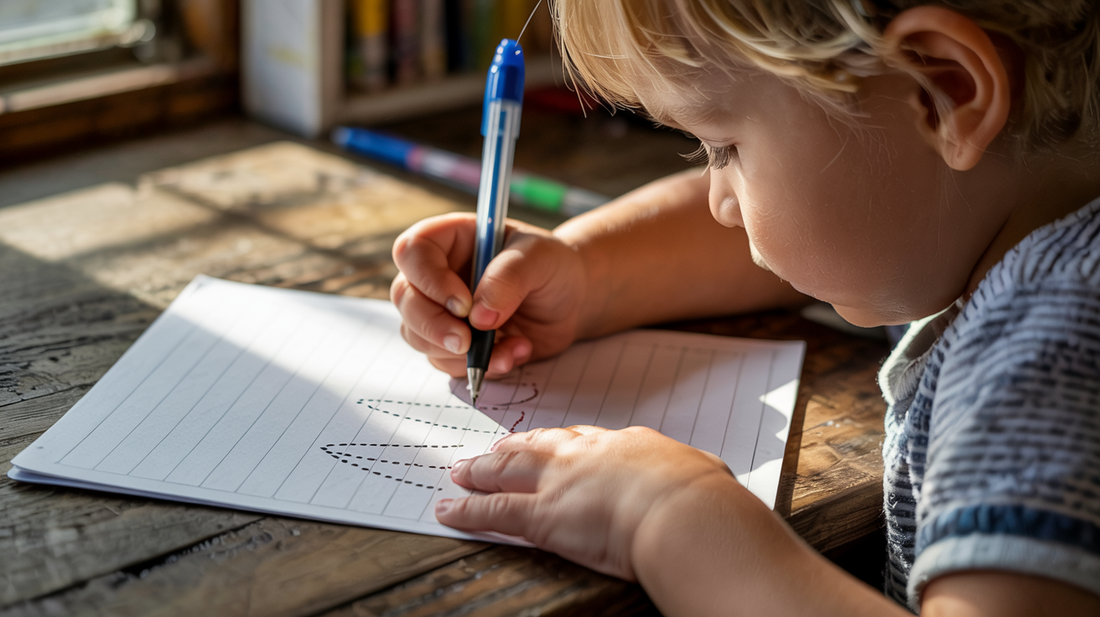
Tracing Letters – A Gentle Start to a Bright Learning Journey
Every milestone in a child's life begins with a simple first step—and when it comes to writing, letter tracing is one of the most valuable early steps your child can take.
Tracing letters is not just about following lines on a page; it introduces essential skills that support confidence, self-expression, and a love of learning that can last a lifetime.
Long before children write their first complete sentence, tracing helps them feel capable and excited about their progress. "It's a hands-on way to build strong foundations for communication, literacy, and independence—all through joyful, meaningful practice.
Let's take a closer look at why letter tracing is such an essential part of early childhood development":
🖋️ 1. Strengthens Fine Motor Skills
Tracing letters exercises the small muscles in a child's hands and fingers—the same muscles they'll rely on for writing, drawing, dressing themselves, and more. Developing fine motor control is key to tidy handwriting and everyday tasks that build self-sufficiency.
✨ Helpful tip: Begin with large, easy-to-follow outlines, and gently introduce more detailed worksheets as your child's skills grow.
📚 2. Supports Letter Recognition in a Fun and Engaging Way
"Recognising letters is a key milestone in a child's early learning journey, and this activity turns it into a fun and rewarding experience. Children become familiar with each letter's distinct shape and sound through repeated tracing and hands-on engagement". This gentle repetition helps lay a strong foundation for reading, spelling, and confident communication—one playful stroke at a time. Through gentle repetition and visual association, young learners connect what they see with how it sounds, turning letters into meaningful building blocks of language. With themed illustrations to match each letter, the experience becomes memorable and playful, encouraging children to learn naturally while having fun.
✨ Helpful tip: Look for worksheets with fun, themed illustrations—like an apple for 'A' or a dinosaur for 'D'. Visuals help children remember what they're learning and keep the experience playful.
🖌️ 3. Encourages a Proper Pencil Grip
One of the early benefits of tracing is learning how to hold writing tools correctly. Establishing a healthy pencil grip helps prevent tension and discomfort later, leading to smoother and more enjoyable writing experiences.
✨ Helpful tip: Start with thicker pencils or crayons for easier handling, then gradually introduce thinner tools as your child gains control.
🤔 4. Develops Focus and Patience
Tracing letters requires concentration, and with regular practice, children build longer attention spans and patience. These skills are helpful during writing tasks and support broader learning and problem-solving as your child grows.
✨ Helpful tip: Keep each session short and encouraging. Celebrate effort and improvement—perfection isn't the goal!
👨🎓 5. Boosts Confidence and Fosters Independence
"Every successfully traced letter is an achievement that makes children feel proud and capable. As their confidence builds, they're more willing to take on new learning challenges, believing in their ability to grow and succeed".
✨ Helpful tip: Display your child's traced letters around the home—a fridge or bedroom wall is perfect—to show them that their efforts matter.
🌈 A Meaningful Start to Lifelong Learning
While tracing letters may seem simple, it lays the foundation for so much more: clear handwriting, early literacy, confidence, independence, and joyful self-expression. It's a small activity with a significant impact: encouraging children to explore, create, and connect through words.
📚 Bibliography & Research References
Cameron, C. E., Cottone, E. A., Murrah, W. M., & Grissmer, D. W. (2016). How Early Fine Motor Skills Impact Learning. Early Education and Development, 27(5), 560–576.
Puranik, C. S., Lonigan, C. J., & Kim, Y. S. (2011). Contributions of Emergent Writing and Emergent Literacy Skills to Name Writing, Letter Writing, and Spelling in Preschool Children. Early Childhood Research Quarterly, 26(4), 465–474.
National Association for the Education of Young Children (NAEYC). (2020). The Case for Pencil and Paper: Fine Motor Development in Early Childhood.
Carlson, A. G., Rowe, E., & Curby, T. W. (2013). Disentangling Fine Motor Skills' Relations to Academic Achievement: The Role of Executive Function. Journal of Educational Psychology, 105(3), 743–755.
These studies support the critical role of tracing in early childhood literacy, motor skill development, and academic readiness.
